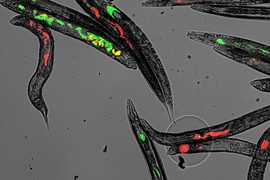Bacteria have evolved all manner of adaptations to live in every habitat on Earth. But unlike plants and animals, which can be preserved as fossils, bacteria have left behind little physical evidence of their evolution, making it difficult for scientists to determine exactly when different groups of bacteria evolved.
Now MIT scientists have devised a reliable way to determine when certain groups of bacteria appeared in the evolutionary record. The technique could be used to identify when significant changes occurred in the evolution of bacteria, and to reveal details about the primitive environments that drove such changes in the first place.
In a paper published online Jan. 28 in the journal BMC Evolutionary Biology, the researchers report using the technique to determine that, around 450 to 350 million years ago, during the Paleozoic Era, several major groups of soil bacteria acquired a specific gene from fungi that allowed them to break down chitin — a fibrous material found in the cell walls of fungi and in the exoskeletons of arthropods — and use its products to grow.
This evolutionary adaptation in bacteria may have been driven by a significant shift in the environment. Around the same time, arthropods such as early spiders, insects, and centipedes, were moving from the oceans onto land. As these terrestrial arthropods spread and diversified, they left behind chitin, creating richer soil environments and a new opportunity for bacteria — particularly those that acquired the chitinase gene — to thrive.
“Before this period, you would have had soils, but it might have looked like the dry valleys of Antarctica,” says Gregory Fournier, the Cecil and Ida Green Assistant Professor of Geobiology in MIT’s Department of Earth, Atmospheric, and Planetary Sciences. “With animals living in soils for the first time, that provided new opportunities for microbes to take advantage and diversify.”
Fournier says that, by tracing certain genes such as chitinase in bacteria, scientists can gain new insight into the early history of animals and the environments in which they lived.
“Microbes contain in their genomes a shadow history of animal life that we can use to fill gaps in our understanding of not only microbes, but also of the early history of animals,” Fournier says.
The paper’s authors include lead author Danielle Gruen PhD ’18, now a postdoc at the National Institutes of Health, and former postdoc Joanna Wolfe, now a research scientist at Harvard University.
Missing fossils
Without a fossil record, scientists have used other techniques to lay out bacteria’s “tree of life” — a map of genetic relationships, showing many branches and splits as bacteria have evolved into hundreds of thousands of species through time. Scientists have established such maps by analyzing and comparing the gene sequences of existing bacteria.
Using a “molecular clock” approach, they can estimate the rates at which certain genetic mutations may have occurred, and calculate the time at which two species may have diverged.
“But that can only tell you relative time, and there’s a huge uncertainty associated with these estimates,” Fournier says. “We have to anchor this tree somehow to the geological record, to absolute time.”
The team found they could use fossils from an entirely different organism to anchor the time at which certain groups of bacteria evolved. While in the vast majority of cases, genes are passed down through generations, from parent to offspring, every so often, a gene can hop from one organism to another, via a virus or through the environment, in a process known as horizontal gene transfer. The same genetic sequence, therefore, can appear in two organisms that otherwise would have entirely different genetic histories.
Fournier and his colleagues reasoned that if they could identify a common gene between bacteria and an entirely different organism — one with a clear fossil record — they might be able to pin bacteria’s evolution to the point at which this gene was transferred from the fossil-dated organism, to bacteria.
Splitting trees
They looked through the genome sequences of thousands of organisms and identified a single gene, chitinase, that appeared in several major bacterial groups, as well as in most species of fungi, which have a well-established fossil record.
They then used algorithms to produce a tree of all the different species with the chitinase genes, showing the relationships between species based on mutations in their genomes. Next, they employed a molecular clock approach to determine the relative times at which each species of bacteria containing chitinase branched from its respective ancestor. They repeated this same process for fungi.
The researchers traced chitinase in fungi to the point at which it most resembled the gene when it first appeared in bacteria, and reasoned that that must have been when fungi transferred the gene to bacteria. They then used fungi’s fossil record to pinpoint the time at which transfer likely occurred.
They found that, following the subsequent transfer of this gene across several groups of bacteria, three major groups of soil bacteria containing the chitinase gene all diversified around 450 to 350 million years ago. This rapid burst of microbe diversity was likely in response to a similar diversification of land animals, and specifically, chitin-producing arthropods, which occurred around this same period, as the fossil record shows.
“This result supports [the idea] that microbial groups tend to acquire genes for using resources as soon as they are available in the environment,” Fournier notes. “In principle, this approach can therefore be used to date many more groups of microbes, using the transfer of other genes that use other resources.”
Fournier is now developing an automated pipeline for detecting useful gene transfers between bacteria and other organisms, from huge amounts of gene data. For instance, he is looking at microbial genes responsible for breaking down collagen, a compound that is produced only in animals, and is found in soft body tissues.
“If we have a shadow history in the microbes of genes that eat soft body tissue, we could maybe reconstruct the early history of soft body tissues, which don’t preserve well in the fossil record,” Fournier says.
This research was supported, in part, by the National Science Foundation and the Simons Foundation.










